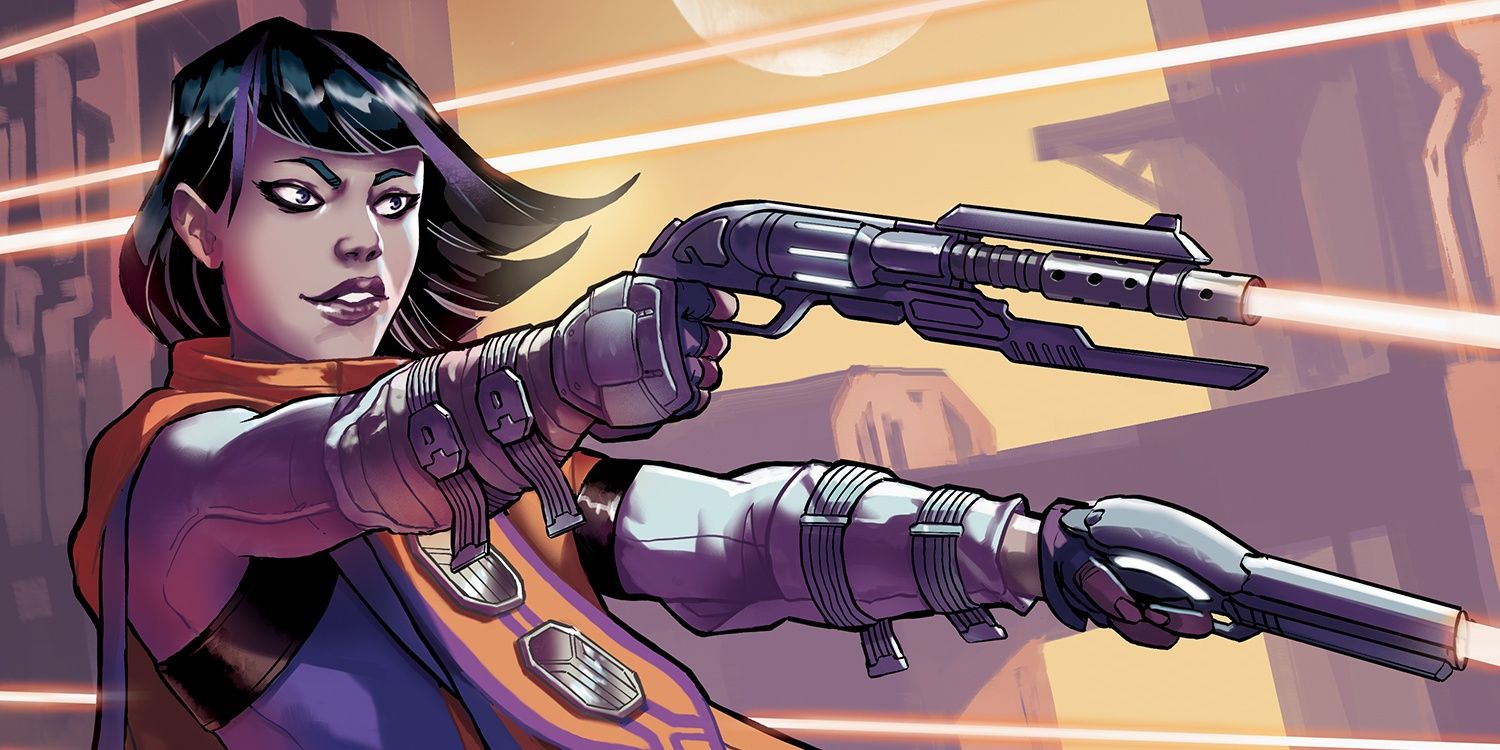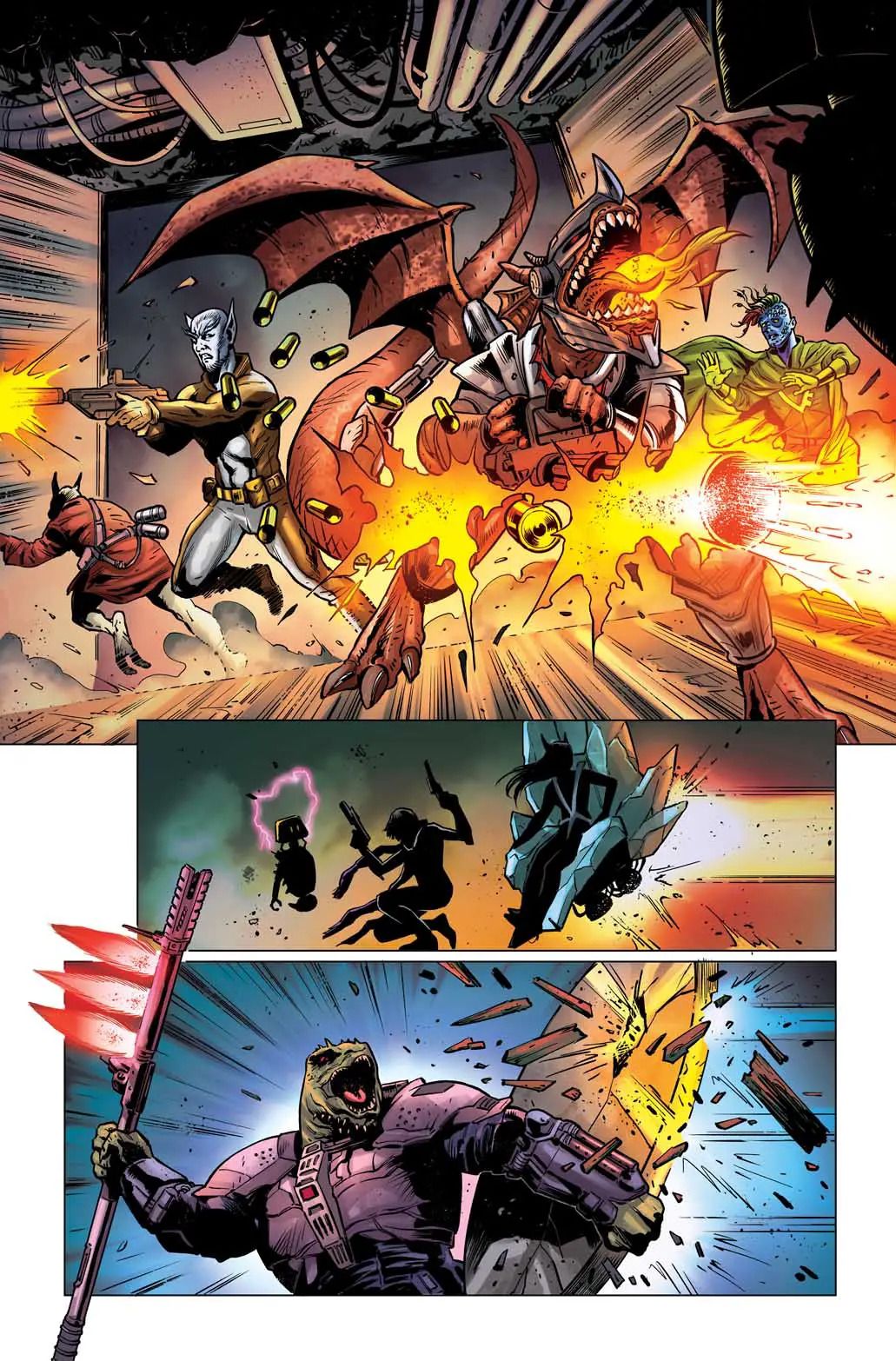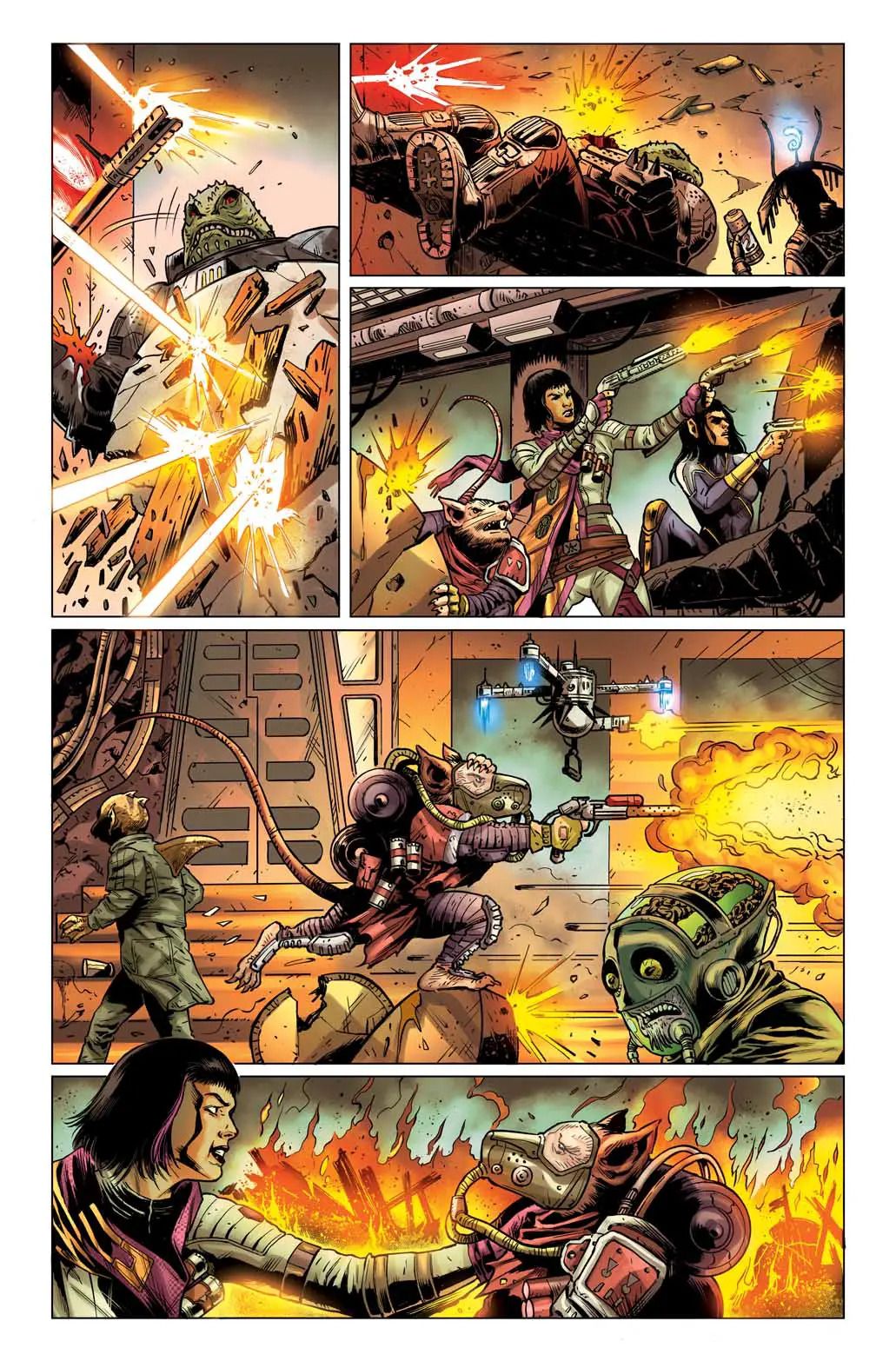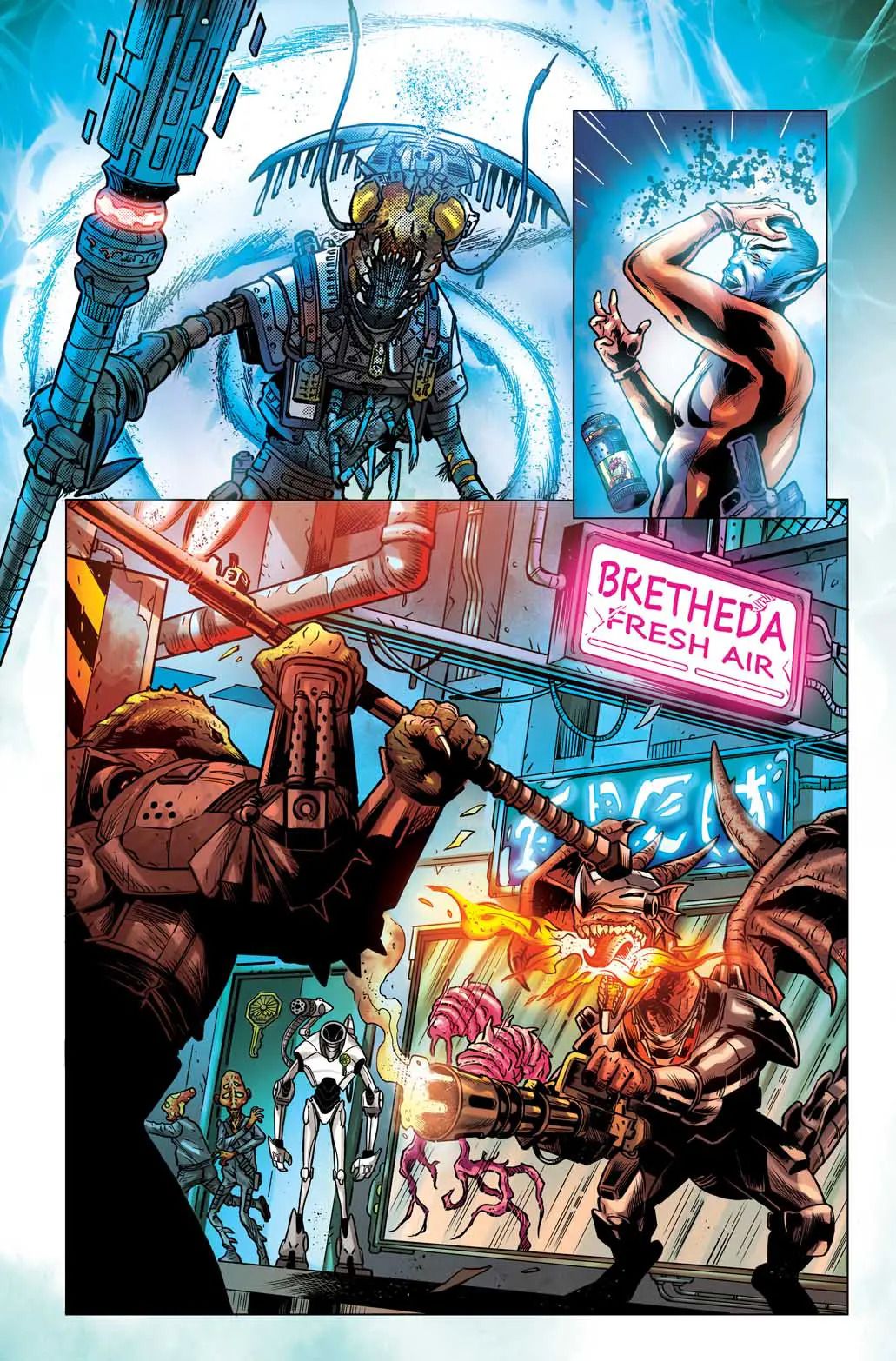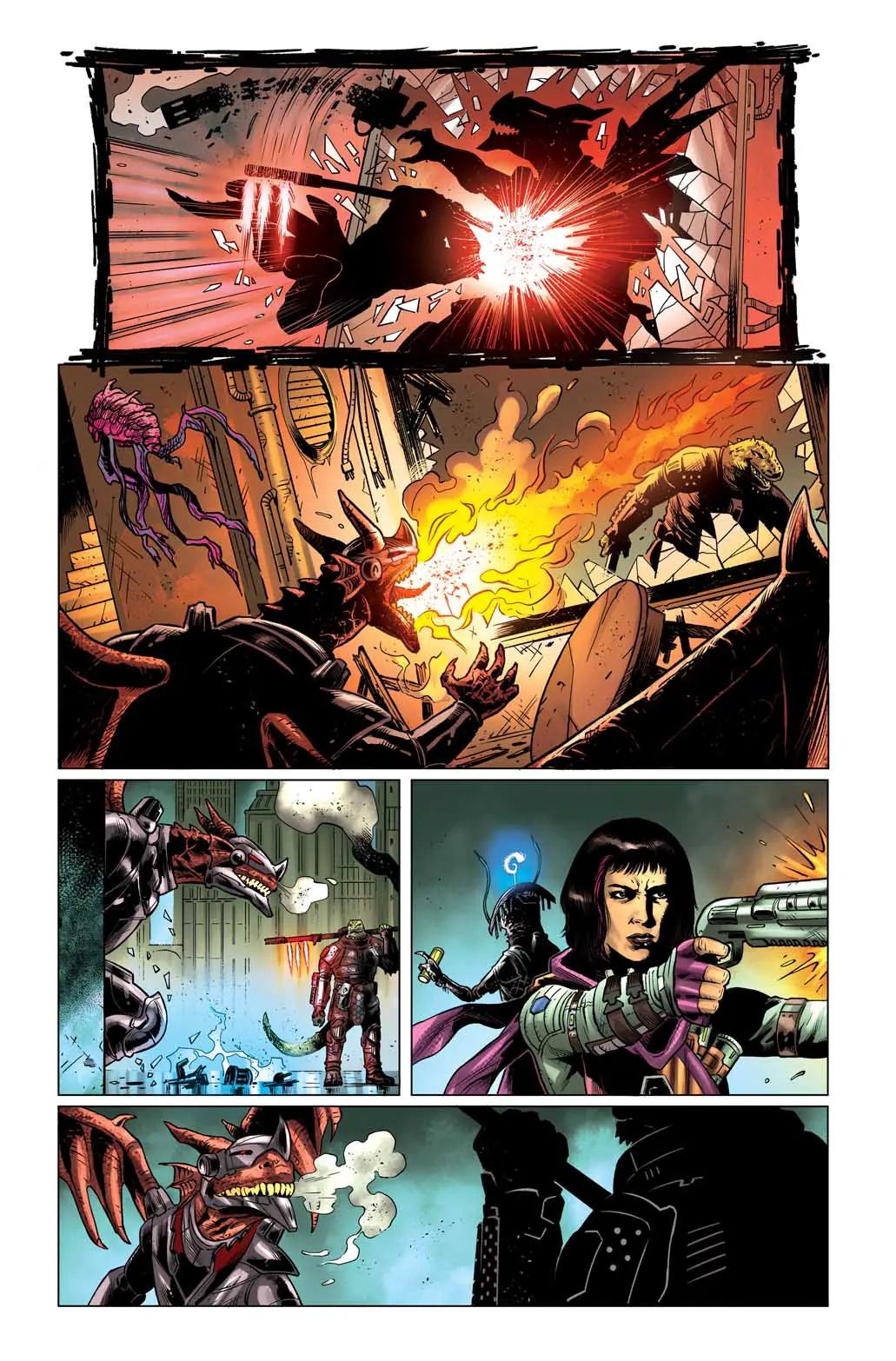Originally founded as a company to publish Dungeon & Dragons' in-house magazines, Paizo made a big splash in the role-playing games market with Pathfinder in 2009, opening tabletop players to a whole new world. Eight years later, Starfinder makes its landfall, improving upon established mechanics and upgrading the sword and sorcery lore for a more sci-fi fantasy take. Former Creative Director James L. Sutter, who has writing credits for many of Pathfinder's comic books, has played a pivotal role in creating an epic new adventure for its successor.
Penned by James L. Sutter, with artwork from Edu Menna and Adriano Augusto, lettered by Tom Napolitano, and published by Dynamite Entertainment -- comes the first Starfinder comic book series, Starfinder: Angels of the Drift, featuring the Iconics! Sutter spoke with CBR about bringing fan-favorite characters to life in the comic book format, translating game mechanics and character personalities onto the page, and finding the perfect antagonists for the story.
CBR: Congratulations on Angels of the Drift being the first Starfinder comic book series to come to the stands. How did this project come together?
James L. Sutter: Even back when we were first dreaming up the game, I'd always thought Starfinder would translate well to comics. We actually cite a number of comics as inspiration in the back of the Core Rulebook, everything from Saga and Bitch Planet to Drive and East of West. So when Paizo's Director of Brand Strategy Mark Moreland and Dynamite's Executive Editor Joseph Rybandt reached out at the start of 2022 about writing Starfinder's comics debut, I leaped at the chance! I'd already written for several of the Pathfinder comics series and loved the experience. Of course, the Starfinder setting will forever be burned into my heart.
Paizo already knew they wanted the series to be tied into the epic Drift Crisis event they were doing in the game books, so they gave me some guidelines, then turned me loose to outline the series and come back to them. Once they and Dynamite greenlit my story, I fleshed it out further with all my character arcs and story beats, then wrote the first issue. That's when Dynamite brought in series artist Edu Menna as well as Adriano Augusto on colors and later Tom Napolitano on letters. I had the luxury of writing the entire five-issue series before the first one ever saw print, so we could make sure everything was tight and adjust scripts as needed as I watched Edu's amazing art come in!
What went through your mind while bringing together Starfinder's classic characters like Navasi, Obozaya, and the others for a team-up of this scale?
Honestly, it was like coming home. Since I was Starfinder's Creative Director throughout the game's creation and launch, our heroes were almost all characters I'd spent a ton of time with, who I'd either come up with myself or helped guide through the process. The only one whose birth I hadn't been present for was Ciravel, the iconic precog. But that character immediately spoke to me. She often uses a hoverchair due to a mysterious and disabling chronic illness, which, as it happens, is also true of my wife. So, the moment I found out I could have her at the party, I immediately knew some scenes I needed to write. But that's how I felt about all of these characters. They're so full of life that you can feel them straining at the leash, ready to run!
With so many personalities coming together, how did you give each character a discernible voice while adhering to their lore?
For me, writing the Pathfinder and Starfinder iconics is like hanging out with old college friends -- [once] you get everybody into a room, the banter comes naturally. The voices grow pretty easily out of their personalities. Obozaya, our reptilian mercenary obsessed with honor, is naturally going to have some choice words about any order to retreat. Bug-like Keskodai, the medic, is going to be discomfortingly cavalier about death on account of being a priest of the death goddess. But he's also going to be the one most concerned with morality as the de facto dad of the group (as well as literal single father to his larva, Chk Chk), and so on.
But in terms of specific writing techniques, one of the key things I try to keep in mind is how each character treats cursing. You can tell a lot about somebody by the way they swear! For example, the group's leader, Navasi, is a reformed space pirate with a revolutionary heart, so her epithets are going to namecheck Besmara, goddess of pirates, and Weydan, god of freedom and equality. Meanwhile, Quig, our ratlike ysoki mechanic, grew up as a junkyard salvager. So his curses are all about rust and machines (as well as the traditional ysoki references to fur, whiskers, tails, etc.).
What can you tell us about the spectra Rute'bajha and their mission to bring Drift Technology to unknown corners of space?
Faster-than-light travel in Starfinder is usually accomplished via engines that help a ship jump into a hyperspace dimension called the Drift, a gift from an artificial intelligence that ascended to godhood. Spectras are a species of intelligent, magical creatures resembling robots who exist to protect the Drift and evangelize its use on behalf of their mysterious machine god.
Rute'bajha is a young, not particularly powerful spectra who was attempting to help their superior bring that faster-than-light technology to a previously uncontacted world when a mysterious calamity called the Drift Crash knocked them out of hyperspace and left them stranded on an interstellar hub called Absalom Station. Navasi and her crew are more than happy to transport them to the new planet, as first contact means the first crack at whatever valuable resources and knowledge that previously unknown society might have gained. But of course, our heroes aren't the only ones interested in new worlds, and some of the others would be decidedly bad news for the planet's residents.
Class features are an important part of Starfinder. How did you want to explore that aspect of the universe with the ensemble cast?
The lovely thing about working with Starfinder's iconics, characters designed to illustrate the game's various playable classes, is that each already comes with a role. Navasi's an envoy, all about social skills and bringing out the best in her companions. Quig, the mechanic, is going to hack and tinker. Keskodai, the mystic, is going to call upon the magic of his goddess to heal or manipulate people, and so forth.
Game mechanics in fiction is always a delicate balance. You want to capture the feel of the game without depicting every spell or laser blast. So when writing for Pathfinder and Starfinder, I have two rules: everything a character does has to be possible under the game mechanics, and every character needs a chance to shine. To that end, when I started outlining the series, I made a big list of all the cool abilities and spells the characters have access to at a particular character level. Then as I wrote, I was constantly consulting the list to ask: What abilities haven't we seen yet? What could the party use to solve a particular problem, and how can I set up a scene or combat to showcase that class options in the most fun and epic way possible?
At the same time, I'm always looking to make sure characters get equal screen time, both in a given issue and over the course of the series, so if Obozaya kicked a lot of ass in this issue, then I need to see more of Ciravel's time-warping magic in the next one, etc. Where this gets trickiest is with magic. You can somewhat handwave how much damage a plasma canon does in a particular scene by telling yourself the attacker rolled well or poorly, but spells in Starfinder are rigidly defined, so if I show Keskodai casting a spell he shouldn't have access to, or if I misinterpret how a spell works, the readers will know!
Lastly, I should mention that there are new game mechanics in the comics as well! Paizo's developers have created new official rules for the back of each issue. It was fun suggesting new player options inspired by the story and incorporating the developers' ideas into the scenes so we could show them in action.
It is fun to see a dragonkin-ryphorian pair in action. What made them the perfect antagonists for the debut issue?
This series is going to head into unexplored territory pretty quickly. So, I wanted to make sure [that] we got as many familiar faces into the first issue as we could. For me, that made the Skyfire Legion a natural choice. When I created them for Pathfinder, they were a band of furry elf-like warriors who bonded near-telepathically with the intelligent dragons they ride. But when we jumped into the future with Starfinder, we evolved the group so that instead of being mount and rider, they became pilot and gunner, using that same intense bond to stay in perfect synch as they fly their deadly two-person fighters. Their love for each other also gives us a nice bit of, well, not humanization, but a reminder that even the bad guys are still people. I'm a sucker for villains with positive relationships. Plus, there's something inherently awesome about a dragon flying a starfighter. I mean, come on.
How did it feel working with the dynamic art style of illustrator Edu Menna and colorist Adriano Augusto?
It's been a dream! Edu constantly shocks me with his endless creativity. I think a lot of artists, when presented with such a thoroughly illustrated world as Starfinder, might buckle under the weight of all that reference or feel like there's no room left for innovation. But Edu has the best of both worlds. He'll draw you a picture-perfect version of an alien species players have seen before and then toss in two more straight out of his imagination. I've always said that my favorite moment in the Star Wars films is the Mos Eisley cantina scene because of the way the sheer density of different aliens makes the universe feel big and weird and real. Edu's giving us that every issue. It's bonkers. At the same time, Adriano has jumped in with both feet, helping bring these new settings to life, always ready and willing to sweat the tiny details. They're both just the nicest, most professional guys, and it's truly an honor to be working with them. I hope they're enjoying my scripts as much as I'm enjoying their pages!
With the opening half delving into heavy exposition, what went into planning the scenes with Menna and letterer Tom Napolitano?
I've always liked wordy, chewy comics. Mike Carey's Lucifer and The Unwritten got me back into comics as an adult. I know that makes me a potential nightmare for artists and letterers, so I try to stay aware and plan ahead: cutting dialogue to the bone, reducing the number of panels on a page, etc. I generally won't start writing anything until I've got every page of an issue blocked out, complete with page turns. Edu and I talked a lot about text flow, making sure we left room for Tom, flipping panels, changing compositions, etc.
That said, we still sometimes get into trouble, and Tom is a wizard at breaking things where they need to break, even if I hadn't planned it that way. While I definitely come out of every script with a clear picture in my mind of what things should look like, with Edu and Tom, there's usually at least one email each issue where I say, "Okay, so, I know I said in the script that we need X, but now that I see what you've done, please ignore me, your way is better!"
You started your comic book writing journey with Pathfinder. What, to you, are the biggest differences in approach between Pathfinder and Starfinder?
In a lot of ways, they're very similar! With both, I'm always trying to capture that feeling of the banter around a gaming table, the way the characters riff off each other, giving each other grief in ways that show how much they really care. The differences, to me, all come down to the individual characters involved. For instance, Pathfinder's fighter, Valeros, might theoretically be serving the same role as Obozaya, the soldier. But he's always going to fight with a wry humor, while Obo's deadly serious in combat (emphasis on the deadly). Of course, the genres are different, which gives you access to different tropes. The whole point of making the Starfinder RPG was to let players (and now readers!) enjoy the full spectrum of science-fantasy adventure, while Pathfinder is full-on sword-and-sorcery. But in the end, whether you call it a starship crew or an adventuring party, both comics are about ragtag groups of heroes out to seek their fortunes in strange, otherworldly settings!
Starfinder: Angels of the Drift takes place in the backdrop of the recent Drift Crisis event. How important is that to the current storytelling?
As I mentioned earlier, it's the inciting incident for the whole series! And while our storyline doesn't deal directly with the cause of the crisis, we'll leave that to the game's players. The whole story revolves around the importance of Drift technology and the consequences of a culture cut off from it.
What's in store for Navasi and her crew next?
If you mean beyond Issue #1, strap in because we've just gotten started! There are going to be Hellknights, alien cultures, daring escapes, and war at a planetary scale, plus heartfelt conversations and hard moral choices packed in between laser battles and giant monsters.
But Angels of the Drift is only a 5-issue story arc. As with any new comic, whether the series continues depends in large part on whether readers buy these initial issues as they release. I hope they do because I'd love to find out what this crew gets up to next!
Starfinder: Angels of the Drift #1 is due out on June 21 from Dynamite Entertainment.

